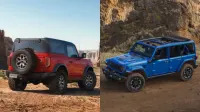2024 Auto Sales: Ford Bronco vs. Jeep Wrangler

Half a decade ago, Ford gave us our first concrete proof that a new Bronco was in the works. At the time, we had no clue what would transpire when the revived 4×4 came to market, and now, nearly four years after is tumultuous launch, production has more or less stabilized, setting the stage for a showdown decades in the making. Sure, we can compare the 2024 Ford Bronco and 2024 Jeep Wrangler all day long, but the proof is in the pudding: Which one do Americans want to buy?
2024 Q1 sales:
- Jeep Wrangler – 38,308 (+ 1.0%)
- Ford Bronco – 24,066 (– 25.9%)
U.S. shoppers were kind to the Jeep Wrangler in Q1 — surprising, considering it’s a convertible. Not only did Jeep outsell Ford in this niche, but Jeep even managed to outsell itself, beating last year’s Q1 total by just a few hundred units. It was one of several big wins for Stellantis, which is rapidly losing volume from the Chrysler 300 and Dodge Challenger and Charger, all of which have been discontinued but still remain in dealership inventories.
2023 Q1 sales:
- Jeep Wrangler – 37,971
- Ford Bronco – 32,430
In 2023, Q1 belonged to Jeep. That trend continued throughout the year; by the end of December, Wrangler ended up outselling the Bronco by nearly 50%. And even with 105,665 units sold, Ford’s midsize off-roader underperformed the previous year by nearly 10%. As we noted in our 2023 sales trends recap, using data from the Covid era to gauge real-world popularity is fraught, but sometimes it’s all we’ve got. In the case of the Bronco, we can’t refer to 2019 sales data. Ford was still working through the aftershocks of the Bronco’s launch and a portfolio-wide initial quality crisis that would have slowed it down in 2023, not to mention the late-summer strike, however both the Bronco and Wrangler were targeted early on by the UAW.
Meanwhile, Jeep managed to sell 156,581 Wranglers in the same period. That was also down from 2022 — by nearly 20%, in fact — and way down from 2019, when Jeep moved 228,032 of its soft-top four-wheelers. In the years leading up to 2020, the Wrangler was in danger of outselling the Toyota Camry. Today, the sedan enjoys a comfortable margin of more than 100,000 units. What happened? In a word, Bronco.
Why they matter:
The beauty of this rivalry is that we, the enthusiast buyers, always win. Competition betters the breed, as it’s said, and we’ve seen clear evidence of that even in the course of a single generation of the Wrangler. The mere threat of Bronco on the horizon nudged Jeep’s engineers to develop the JL Wrangler as we know it today. Its predecessor had just one engine (the 3.6-liter Pentastar V6); the current truck has now been offered with five, including a 375-horsepower plug-in hybrid, a 470-horsepower V8 and a since-discontinued six-cylinder diesel. Since its launch, Ford has been hard at work keeping one step ahead of Jeep, with a Raptor model that nips at the Wrangler Rubicon 392’s heels in a straight line but can run circles around it on soft surfaces.
Think about it this way: Jeep’s engineers could have made the 5.7-liter Hemi fit in the JK Wrangler, but they didn’t. Why? Because the Wrangler sold well just the way it was. Compounding that, it owned a segment consisting only of itself. With no pressure to be better, it simply carried on, and that’s an approach Jeep can no longer afford to take. The result is more cool Jeeps. What a world!
What to look for in 2024:
In a word, even footing. Ford is no longer as mired as it was when the Bronco launched, and with supply chain issues largely easing, things should only go smoother in 2024. Another item of note is a pesky little vehicle called the Toyota Land Cruiser. This time around, Toyota is aiming for the mainstream, meaning the Land Cruiser might be affordable enough to be considered alongside the Wrangler and Bronco. And since it shares its underpinnings with the new Tacoma, there’s even the potential for more enthusiast-friendly options. Even if it doesn’t end up competing directly, it could siphon off buyers who want a more premium experience without shelling out for a luxury badge.




